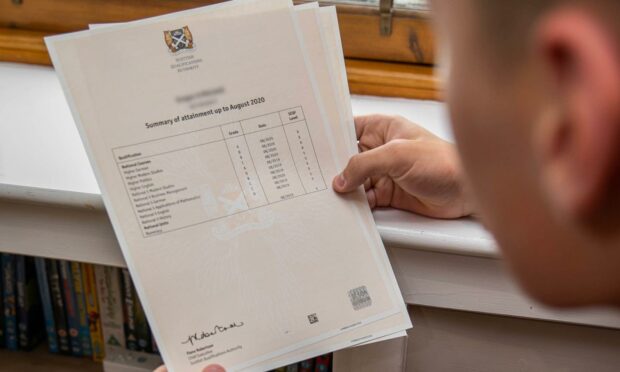While this year’s National 5, Highers and Advanced Highers pass rates are down on last year’s, they remain considerably higher than recent pre-Covid years.
Exams were cancelled both this year and last, with the 2021 grades determined by teachers based on assessments in school.
Last year, around 123,000 results downgraded by the Scottish Qualification Authority were restored to teachers’ estimate, so comparison is warned against.
Pass rates and previous years
The proportion of young people achieving in an A to C in National 5 was 85.8%, compared to 89% in 2020 and 78.2% in 2019.
For Highers that figure was 87.3% down from 89.3% in 2020 but up from 74.8% in 2019, and for Advanced Highers it was 90.2%, down from 2020’s 93.1% but up from 79.4% in 2019.
High proportion of A grades
A figure that stands out from this year’s results is the high proportion of A grades.
Some 47.6% of Higher entries result in an A pass. Last year the proportion was 40% but in the previous three years it was just over 28%.
For English A to C passes were achieved by 91% of entrants at Nat 5 level, 88.2% at Higher and 91.8% at Advanced Higher.
In maths the A-C pass rates were 73 at Nat 5, 80.1% at Higher and 87% at Advanced Higher.
Subjects with the lowest and highest A passes
The subject which saw the highest proportion of A passes for Nat 5 pupils was Latin, at 95.5%, and the lowest was in application of maths, with 22.7%.
In Higher, 90.6% of those who tackled Latin got an A, but only 29.2% of care candidates achieved that.
For Advanced Higher, the highest A grade result was for Italian, 90.9%, and the lowest design and manufacture, 30.6%.
Gap between richest and poorest
As in previous years, young people living in the most deprived areas of Scotland were less likely to achieve an A pass at Higher level than those in the least deprived areas.
That gap widened this year compared to last, with 35.6% of Higher candidates in the most deprived areas getting an A compared to 57.7% in the least deprived.
There were 22.1 percentage points of difference this year compared to 20.6 last year, and 21.9 the year before.
“Strong set of results”
Fiona Robertson, the SQA’s chief executive and Scotland’s chief examining officer, described them as a “strong set of results” which recognised learners’ hard work and resilience.
She said: “This has been a very challenging year for everyone and today is a results day like no other.”
She also insisted that the alternative certification model developed ensured that young people “received the qualifications they deserve, and can move on to further or higher education, training or employment, with confidence”.
Ms Robertson said: “Everyone worked hard to ensure the model was credible and fair so we can all have confidence in the certificates that have been awarded today.
“I want to thank everyone who has played their part, directly or indirectly, in delivering for learners this year in the most exceptional circumstances.”










